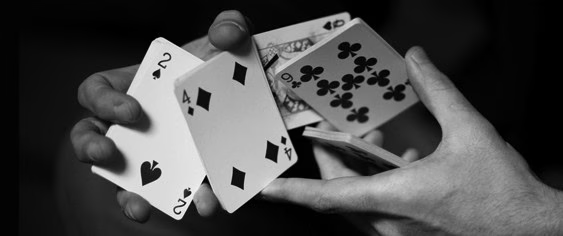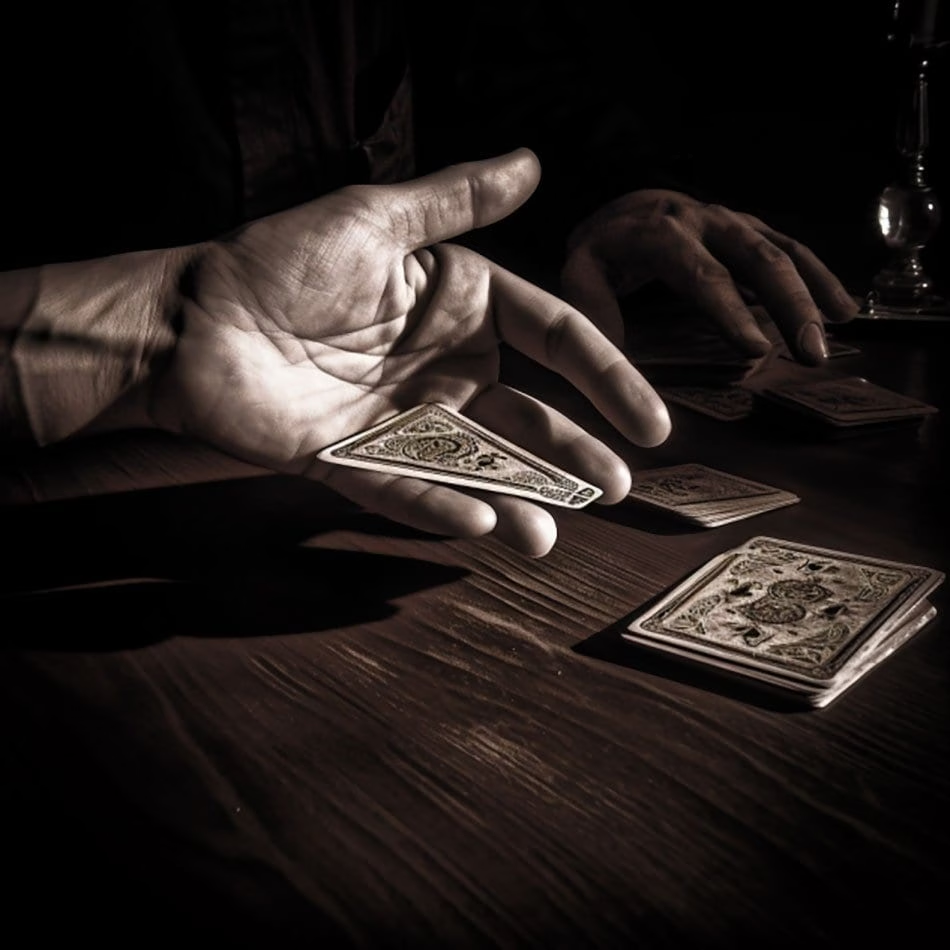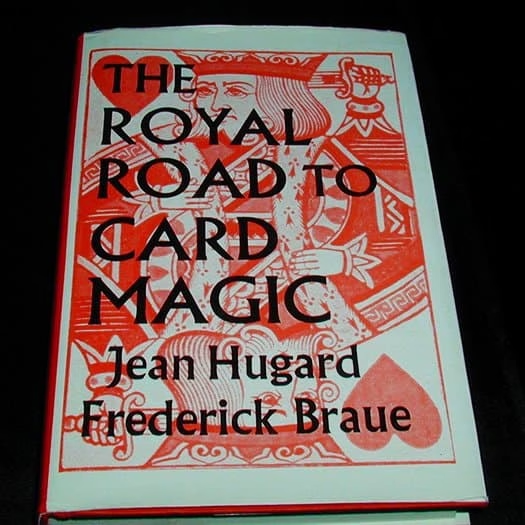Card sleight of hand
Dealing in: the art of card magic

Stacked decks and shuffled schemes
To create illusions, magicians present one reality to their audience while concealing another. They are secretly performing actions that make their magic tricks work. They hide the method or mechanics of their tricks by combining two essential magic techniques.

Shuffling into mystery
The first magic technique is the sly physical manipulation of objects with imperceptible movements, commonly known as Sleight of hand. The second magic technique is misdirection. Some card sleights are impervious to a keen observer, while other card moves require strong Misdirection — a distraction from a conspicuous card maneuver. Misdirection is focusing the audience’s attention on any object, action, or idea other than the method; so the spectator will not notice the movements which achieve the magic trick. Card sleight of hand, known as prestidigitation and legerdemain, is a collection of dexterous hand movements designed to manipulate playing cards and skillfully deceive spectators. It is a fundamental discipline that makes card tricks work in card magic.
The card cheat’s conjuration

Step onto the Royal road to card magic and master card sleight of hand.
How to learn card sleight of hand
How do you start to learn sleight of hand card tricks in a structured and focused way? That’s a question that gets overlooked by many beginners as they race from magic secret to magic secret, soaking in as many new secrets as they can.
- Read the best book on card magic, The Royal Road to Card Magic.
- Practice.
- Practice.
- Practice.
Repeat the above as a loop — theory, practice, theory, practice. The key to focused practice is to choose a group of core techniques that you plan to work on, then create a structured practice schedule.
How to practice sleight of hand card magic

If to this delicacy of manipulation is added a suavity of manner, accompanied by a never-failing cool daring, then the perfection of a magician is attained.
Choosing the card technique
Start by creating a list of core moves that you would like to develop. This should be short, as each move will be the subject of a long period of focused work. Scale your list down to 3 to 5 key techniques that you really want to master. For example:
- The one handed top palm
- The false shuffle
- The double lift
- The top change
These will be the foundation for your practice over the next 6 months of magic training. You can make an entire career if youmastered the top change, but if you try to learn 20 or 50 techniques when you haven’t even mastered one, then no one will ever remember you. Once you have a core list, pick one of the techniques to start your training.
Creating a timetable
Now we have selected a card sleight, we can build an effective program to give structure and a pace to our training. It’s easy to rush in and start practicing every moment you can. For some people this works fine, but it can lead to ‘burn out’ from boredom or impatience to move on to something new. If you find that you struggle to commit to serious practice, and skip from technique to technique without mastering anything, you may find that a structured practice schedule will greatly help you. We recommend daily practice, in short sessions.
- 10 minutes practice in the morning
- 10 minutes practice in the evening
Choose the first technique that you will work on, and focus on only that move for the next 2 weeks. Drill the move slowly for 10 minutes every morning and 10 minutes every evening. Practice slowly,focusing on performing the move accurately and smoothly.
What is the most important secret to mastering card sleight of hand?
The secret to mastering card sleight of hand is Practicing the real move.
Practice the real card move
Don’t practice only the secret, false move — also, intermittently, practice the Real move. In other words, if you are learning a false shuffle, practice the false overhand shuffle and practice its legit equivalent. Practice the false version, then the legit shuffle, then the false, then the legit. By degrees, you strive to make the false and the real converge. So both look almost exactly the same. Speed Your practice should be slow. The goal is on perfect technique than speed. If you rush the moves, assuming that faster is better, you will be making small errors, which become reinforced by repetition. Speed is a side effect of good technique, not part of the technique itself. A poor sleight-of-hand artist makes quick, jerky movements. These nervous movements arouse suspicion.
Assessment
After 2 weeks, video your performance of the technique and watch it back. Have a critical eye and make note of:
- Mistakes in your technique.
- Hesitation.
- Unconscious ‘tells’ that you might not have been aware of.
- How the flow of your actions look natural.
If you are happy with the technique, you can now move on to put it in action. If not, repeat the drill program for another week.
Application and rehearsal
Once a technique has been practiced, you can’t rest there. You need to keep it fresh and familiar over time. Any move you learn is a waste of time, if you don’t have an application for it. You need a magic trick that you want to perform that uses the technique. As you start rehearsing the full trick, you reinforce your performance of the techniques within it. This keeps your skills active over time. Repeat the practice drill for the whole magic trick, repeating it a few times each day. Once you are happy with your progress through rehearsal, you are ready to start again at step 1 with the next technique you wish to master.
Easy card sleight of hand tricks
The one-handed cut for card magic tricks
This cut, known to magicians as a “charlier” cut, allows you to separate the deck into two portions and switch their positions—all with only a single hand. It’s the first flashy cut that most magicians use as a flourish to augment card magic tricks. At first you will falsely believe that your hands are too small. Keep practicing.
One-handed triple cut
Here’s another one-handed cut. It’s flashier than the charlier and more secure, but more difficult to get the hang of.
Basic card shuffle for card magic tricks
This basic dovetail shuffle is what most professionals use when they start their card tricks. This move includes a cool flourish called the “bridge” that you can perform at the end.
The swivel cut
The swivel cut is a fundamental cut that forms the basis of more advanced moves, and it’s generally more for flourishes than card magic tricks. The swivel cut is flashier than the pivot cut. Like the pivot cut, it requires the use of both hands and separates the deck into two portions and switches their positions. The difference is that the upper half of the deck turns 180 degrees as it separates from the deck.
The hindu shuffle
The hindu shuffle is a powerful move for magicians because it’s a false shuffle, meaning you can maintain the order of some of the cards. Though the shuffle is mostly used by magicians and not the general public, it has lots of applications. In its basic form, it can be used to mix a deck of cards by separating the deck into sections and rearranging them. Once you learn how to do this, you can start adding the hindu shuffle to your card magic tricks.
31 card sleight-of-hand techniques to master
1. Double lift
The double lift is a fundamental technique in card magic, allowing the magician to lift two cards as one, giving the illusion of a single card. It was first described in 1902 by s.w. Erdnase in his book, The Expert at The Card Table.
2. False shuffle
A false shuffle maintains the order of a deck while appearing to mix the cards, a crucial technique for any card magician. There are many variations of false shuffles, including the strip shuffle, the riffle shuffle, and the overhand shuffle. The first known description of a false shuffle was in 1760 by john northern hilliard in his book, Greater Magic.
3. Top change
The top change is a stealthy method for exchanging cards between the magician’s hand and the top of the deck. It was first described in Royal road to card magic by jean hugard and frederick braue.
4. Classic pass
The classic pass enables the magician to secretly control a selected card’s position within the deck. It was first described by jean hugard and frederick braue in their classic book, Expert Card Technique.
5. Hindu shuffle
The hindu shuffle is an alternative method of shuffling cards, which can be combined with various false shuffles and controls. It is said to have originated in india.
6. Overhand shuffle
The overhand shuffle is another shuffling technique, allowing for versatile card control and false shuffling. It is believed to be one of the oldest shuffling techniques, dating back to at least the 16th century.
7. Elmsley count
The elmsley count is a false counting technique that allows the magician to hide a card while counting a packet of cards. It was first described by alex elmsley in his book, The Collected Works of Alex Elmsley.
8. Glide
The glide is a technique used to secretly move the bottom card of a deck, enabling the magician to control cards without detection. It was first described in Royal road to card magic by jean hugard and frederick braue.
9. Pinky break
The pinky break is a method of secretly marking the position of a card within the deck, providing a reference point for subsequent sleights. It is one of the most basic and commonly used techniques in card magic.
10. Palm
Palming is a technique that allows the magician to conceal a card in their hand while making it appear empty. It is one of the most versatile and essential techniques in card magic.
11. Double undercut
The double undercut is a card control technique used to move a selected card to a position within the deck. It was first described in The Expert at The Card Table by s.w. Erdnase.
12. False cut
False cuts are methods of apparently cutting the deck while maintaining its order, essential for many tricks. There are many variations of false cuts, including the swing cut, the charlier cut, and the false table cut.
13. Cull
The cull is a technique for secretly moving cards from the middle of the deck to the top or bottom while spreading through the deck. The Hofzinser Spread Cull was invented by Johann Nepomuk Hofzinser and first described in Expert Card Technique by Jean Hugard and Frederick Braue.
14. Zarrow shuffle
The zarrow shuffle is a false shuffle that convincingly mixes the cards without disturbing the order. All 52 cards remain in the same position as they were before. It was named after its creator, herb zarrow.
15. Top palm
The top palm is a technique for secretly palming the top card of the deck while making it appear undisturbed. The one-handed top palm is a deadly weapon in the right hands.
16. Bottom deal
The bottom deal is a deceptive dealing technique where the magician deals cards from the bottom of the deck instead of the top. It is one of the most difficult and advanced card sleights in magic.
17. Second deal
The second deal is another deceptive dealing technique in which the magician deals the second card from the top instead of the top card. It was first described in The Expert at The Card Table by S.W. Erdnase.
18. The diagonal palm shift
The diagonal palm shift is a method for secretly moving a card from the middle of the deck to the palm of the hand. It was best described in Card College by Roberto Giobbi.
19. The Vernon transfer
The Vernon Transfer is a technique for convincingly switching one card for another, creating the illusion that a card has changed. It was named after its creator, Dai Vernon.
20. The double undercut control
Invented by the cardician and prolific magical thinker, “the professor” dai vernon, the double undercut control allows the magician to control the position of a card within the deck by using a combination of cuts and shuffles. It was first described in “expert card technique” by jean hugard and frederick braue.
21. Erdnase change
The erdnase change, found in The expert at the card table, is a color change technique that makes one card visually transform into another.
22. The side steal
Invented by Nate Leipzig, the side steal — called side slip — is a method for secretly moving a card from the middle of the deck to the top or bottom, allowing for effective card control.
23. The marlo tilt
The tilt is a technique for creating the illusion of inserting a card into the middle of the deck while placing it second from the top. Ed Marlo wrote about it in his 1938 book Pasteboard presto, but went into further detail in his classic book Revolutionary card technique.
24. The bluff pass
The bluff pass is a bold technique that allows the magician to control a card by seemingly doing nothing at all, as the spectator returns the selected card to the pack of cards.
25. The buckle
The buckle is a technique used to secretly gain a break below one or multiple cards, providing a reference point for various sleights.
26. The spread pass
The spread pass is a technique for controlling a card’s position within the deck while spreading the cards. It was first described in Expert card technique by jean hugard and frederick braue.
27. The top change control
This control method combines the top change with other techniques to allow the magician to control a card’s position within the deck.
28. The hofzinser spread cull
This technique allows the magician to secretly move cards from the middle of the deck to the top or bottom while spreading through the deck. It was named after its creator, johann nepomuk Hofzinser.
29. The tenkai palm
The tenkai palm is a versatile palming technique that allows the magician to conceal cards in various positions. It was named after its creator, teiji “tenkai” watanabe.
30. The multiple shift
The multiple shift is a technique for secretly controlling the position of multiple cards within the deck.
31. The classic force
The classic force is a technique for seemingly allowing a spectator to choose a card freely, while forcing them to pick a predetermined card.
The 3 most useful sleights with a deck of cards
Straight from a professional prestidigitator and Virtual magician Jon Finch, here are the three sleight of hand card trick maneuvers you’ve got to master if you want to be proficient with playing cards. Master these, and you can do miracles with cards.
The one handed top palm
Not only can you perform wonders with the top palm, but it will get you out of all kinds of trouble as well. Knowing how to palm a card (any palm, but the one handed top palm is the most useful) is better than not knowing how to palm a card. Once you can do card palming, you can make a card appear anywhere—under the spectator’s drink, under the saltshaker, in your pocket, even in the spectator’s pocket!
The top change
The top change, beneath a dash of misdirection, will blow people’s minds. Obviously you don’t want them shouting, “wow, my mind is blown by that top change!” like the card palm, the top change is a skill you’ll spend years mastering with the hope that nobody will ever see it. With the top change, as the name suggests, you can transform any card to any other card. Magicians most often use the top change to change an indifferent card into the spectator’s selected card.
The diagonal palm shift
The diagonal palm shift is a combination of a palm and a side steal (also called side slip). Not all magicians who use the side steal palm the card (most do). Master the diagonal palm shift and you won’t need to learn the side steal, because you can simply diagonal palm shift the card out of the deck. But without mastery of the diagonal palm shift, the 3rd most useful sleight with cards is the side steal. Unless you count the false shuffle, in which case the false shuffle is the most used skill.
Honorary mentions
- The false shuffle
- The double lift
- The classic force
- The Hofzinser spread cull
- Any convincing card control (for the love of Dai Vernon, Not the disgusting double undercut)
If a magician master only one of these five, he can do an entire show withthat one card move and make a reputation. But each move requires assiduous practice and courage. In the beginning, you’ll believe everyone will notice the move. But once you master any of these sleight of hand card moves, you will be able to do them in your sleep, and Nobody will see it. It will look easy and natural.
Sleight of hand card tricks
- The false cut The magician appears to make a real cut but leaves the deck in its original order. They can use this to control or force spectators’ cards.
- Palming After laying his hand on the top of the deck, the magician pulls the slightly curled and clenched hand away with the top card secured and concealed in the palm of their hand. As sleights go, palming cards is an easy magic trick.
- The Elmsley Count / ghost countUsing a block push (forcing a card out slightly) and double peel (taking two cards), the magician conceals a card while counting out a pre-established number of cards.
- The riffle force In this classic force technique, the magician applies pressure to the top card of the deck, maintaining control over it while pulling a chunk of other cards out of the deck. As a result, they know exactly where the top card is.
- The double lift The magician lifts the top two cards as one, making it appear as if they only picked up the top card. When they show the card to the audience, spectators believe they are seeing the top card when it is the second card. Thus, when the top card is relocated within the deck, the magician retains the card the audience saw on top of the deck.
- The double undercut By pushing down slightly on a card placed into the middle of the deck, the magician separates it from the top half of the deck. Then, by halving the bottom half of the deck, creating three total piles, the magician shifts those piles, creating the illusion that the card is lost in the deck when in reality the magician brought it back to the top of the deck.
- The spread cull The magician relocates a card chosen from the middle of the deck to the bottom by splitting the deck, forcing it out slightly, then dragging the card across the faces of the spread half of the deck and moving it to the bottom of the pile while closing the piles.
- The one-hand cut Known as a “Charlier” cut, this is when a magician uses a single hand to separate the deck into two portions, flipping the upper half and lower half to switch their positions. It adds a cool flourish to easy card tricks, and it’s a necessary move to progress to a more advanced card trick. Plus, it leaves an empty hand free to perform misdirection or additional sleights.
- The pivot cut Whereas the one-hand cut involves flipping two portions of cards to switch their positions, the pivot cut twists the two stacks to achieve the same effect.
- The swivel cut Invented by Nate Leipzig, the magician breaks the deck into thirds, swiveling them in such a manner that the sections appear to change places while ultimately staying in the same order. This can create the illusion that someone’s card is in the middle of the deck when the magician controls it on the top or bottom of the deck.

